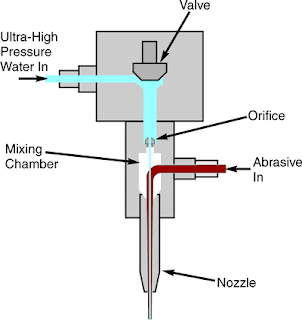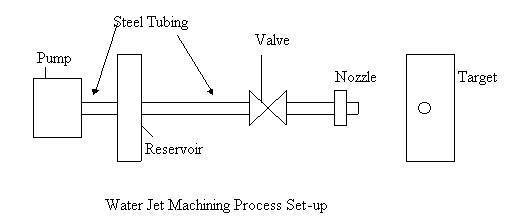Water-Jet Machining (WJM)
Water Jet Machining (WJM) is a non-traditional machining process used to cut and machine soft and non-metallic materials.
It involves the use of high velocity water jet to smoothly cut a soft workpiece. It is similar to Abrasive Jet Machining (AJM).
In water jet machining, high velocity water jet is allowed to strike a given workpiece. During this process, its kinetic energy is converted to pressure energy. This induces a stress on the workpiece. When this induced stress is high enough, unwanted particles of the workpiece are automatically removed.

Construction of Water Jet Machining (WJM):
The apparatus of water jet machining consists of the following components:- Reservoir: It is used for storing water that is to be used in the machining operation.
- Pump: It pumps the water from the reservoir.
- Intensifier: It is connected to the pump. It pressurizes the water acquired from the pump to a desired level.
- Accumulator: It is used for temporarily storing the pressurized water. It is connected to the flow regulator through a control valve.
- Control Valve: It controls the direction and pressure of pressurized water that is to be supplied to the nozzle.
- Flow regulator: It is used to regulate the flow of water.
- Nozzle: It renders the pressurized water as a water jet at high velocity.

Working of Water Jet Machining (WJM):
- Water from the reservoir is pumped to the intensifier using a hydraulic pump.
- The intensifier increases the pressure of the water to the required level. Usually, the water is pressurized to 200 to 400 MPa.
- Pressurized water is then sent to the accumulator. The accumulator temporarily stores the pressurized water.
- Pressurized water then enters the nozzle by passing through the control valve and flow regulator.
- Control valve controls the direction of water and limits the pressure of water under permissible limits.
- Flow regulator regulates and controls the flow rate of water.
- Pressurized water finally enters the nozzle. Here, it expands with a tremendous increase in its kinetic energy. High velocity water jet is produced by the nozzle.
- When this water jet strikes the workpiece, stresses are induced. These stresses are used to remove material from the workpiece.
- The water used in water jet machining may or may not be used with stabilizers. Stabilizers are substances that improve the quality of water jet by preventing its fragmentation.
Advantages of Water Jet Machining (WJM):
- Water jet machining is a relatively fast process.
- It prevents the formation of heat affected zones on the workpiece.
- It automatically cleans the surface of the workpiece.
- WJM has excellent precision. Tolerances of the order of ±0.005″ can be obtained.
- It does not produce any hazardous gas.
- It is eco-friendly.
Disadvantages of Water Jet Machining:
- Only soft materials can be machined.
- Very thick materials cannot be easily machined.
- Initial investment is high.
Applications of Water Jet Machining:
- Water jet machining is used to cut thin non-metallic sheets.
- It is used to cut rubber, wood, ceramics and many other soft materials.
- It is used for machining circuit boards.
- It is used in food industry.

No comments:
Post a Comment